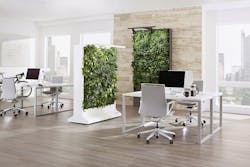Are Your Conference Rooms Stifling Decision-Making?
How well can people concentrate in your conference rooms? Long meetings in enclosed, poorly ventilated spaces can quickly produce enough carbon dioxide to affect the cognitive ability of the people inside. It hurts their ability to focus, make decisions and produce innovative work.
In short: a lack of fresh air can literally hurt your organization’s bottom line.
You don’t necessarily need to retrofit your building with expensive upgrades, however. Here’s what you can do to remedy stuffy meeting spaces.
Understand the Problem
A 2016 report by Gensler illustrates the effects of carbon dioxide buildup. The firm tracked the temperature, humidity, VOCs, and levels of carbon dioxide and particulate matter in two identical conference rooms. A green wall was installed in one of the conference rooms to determine what impact (if any) the plants would have on the air quality in the room.
The living wall in the Gensler study reduced carbon dioxide levels by an average of 24 percent and particulate matter by 21 percent compared to the room with no plants.
Predictably, the conference room with the plants in it had lower levels of carbon dioxide than the other room. The CO2 level also fell faster in the room with the green wall than it did in the other one. However, the research also turned up some surprising findings. GIGA, one of four firms participating in the three-year Gensler study, explains that three people sitting in a mid-size conference room produced an ability-limiting level of CO2 within an hour.
Carbon dioxide peaked at 1,600 parts per million (ppm) in the conference room without plants. That significantly exceeds the human comfort level for CO2 exposure (1,000 ppm, according to ASHRAE). It’s also beyond the point when decision-making ability starts to drop.
[On topic: Living Walls Put the ‘Green’ in Greenbuild]
“At CO2 levels of 1,400 ppm, the ability of the brain to take the right decisions begins to be impaired, with cognitive performance dropping by an average of 50 percent compared to optimal indoor levels of 600ppm,” GIGA noted in a review of the data. “At 2,500, cognitive dysfunction kicks in.”
What to Do About It
The living wall in the Gensler study reduced carbon dioxide levels by an average of 24 percent and particulate matter by 21 percent compared to the room with no plants. It also returned to baseline levels after a CO2/particulate matter spike much quicker than the room without the living wall, Gensler notes.
Tackle any suspected air quality problems by doing an inspection. Make sure you’re monitoring temperature, humidity and carbon dioxide if you have a building automation system that can keep track of that data.
Check air handling units to make sure the dampers are working right and that the minimum outside air setting is correct. Use good quality filters and change them on schedule so you’re not bringing in particulate matter and outside pollutants.
BUILDINGS Checklist
Preventive Maintenance
Are you practicing preventative maintenance? When you stay on top of upkeep, you avoid costly emergency repairs and equipment failures, all of which eat into your hard-earned budget.
Use this checklist to keep major building systems—HVAC, roofing, plumbing and lighting—in good working order. Get yours here >>
A room that’s still stuffy despite a functional HVAC system may need some plant therapy. A living wall like the one tested in Gensler’s Shanghai office may be an option.
Retrofitting green walls is easier than ever as long as you can get water into the contained irrigation system. Make sure to pick plant species that will stand up to repeated handling – people often can’t resist touching the plants. Species that are common in your area will be easier to maintain.
Potted plants are another alternative, especially for offices where a full green wall isn’t feasible.
A landmark 1989 study by NASA called for at least one plant for every 100 square feet. Use the results of your inspection to inform your plant choices. Some species are better than others at removing certain VOCs, for example, so you may want to focus on certain plants depending on the issues in your specific office.
[Related: 5 Air Purifying Indoor Plants]
The cause of poor office IAQ is notoriously hard to pin down, but thoughtful attention to detail, smart HVAC maintenance and good plant practices can help.
Take care of the fresh air in your building and let your organization reap the rewards in the form of better concentration, higher productivity and improved innovation.
Two handpicked articles to read next:
About the Author
Janelle Penny
Editor-in-Chief at BUILDINGS
Janelle Penny has been with BUILDINGS since 2010. She is a two-time FOLIO: Eddie award winner who aims to deliver practical, actionable content for building owners and facilities professionals.


